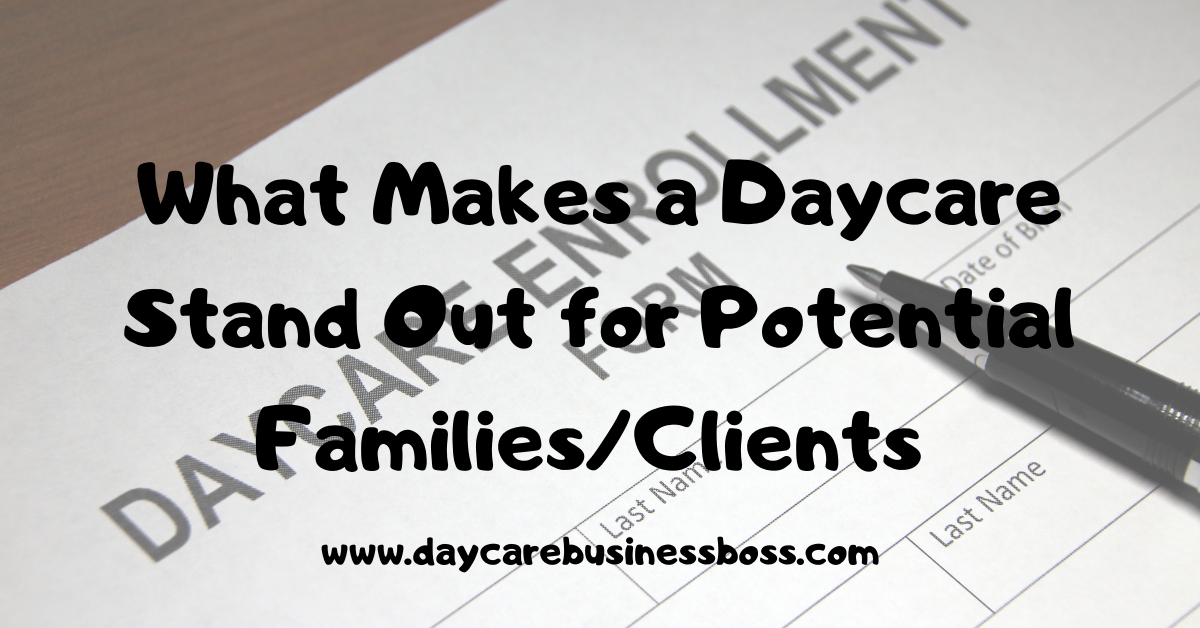When it comes to starting a new daycare, an important factor to your success is how the services you provide for potential families and clients will make your daycare stand out from the competition. In this article, to better help you succeed in your new business, we will discuss what makes a daycare stand out for potential families and clients.
The top 5 factors that will directly affect how your daycare will stand out for potential families and clients include:
-
Safety Measures and Cleanliness
-
Nutritional Standards
-
Communication
-
Staff Quality
-
Curriculum
While each of these factors is equally important to your success, we will discuss in detail why each factor is important and what you can do to make your daycare stand out.
1. Safety Measures and Cleanliness
A parent’s number one priority is naturally the safety of their child, and the cleanliness of your daycare will play an important role in ensuring that safety. When it comes to making your daycare stand out to potential  families, it is vital to place the utmost importance on providing the cleanest and safest environment possible!
families, it is vital to place the utmost importance on providing the cleanest and safest environment possible!
Whether you have your building for your daycare or in your home, some of the more basic safety measures that you can implement include:
- Cover electrical outlets to prevent shock and electrocution
- Ensure all doors and windows are closed securely and locked if necessary.
- Gate all stairways to prevent falls
- Child lock all cabinets and cleaning supplies to prevent possible poisonings
- Have clear emergency procedures set in place
- Ensure all play equipment is sturdy and can’t fall over during play
- Ensure medication is stored in a clearly labeled bin for each child
Other safety measures that I highly recommended to ensure safety is being held to a high standard, as well as ensuring your daycare stands out, can include:
- Provide a keypad entry on your door, and change it regularly to ensure that no one comes into the daycare that shouldn’t be
- Fence in the play area to prevent a child from wandering off
- Covering all hard corners and surfaces to avoid injuries
- Picking up and throwing away any broken toys to prevent any accidental injuries during playtime
- Ensuring playground equipment is secure
- Secure area rugs in place with double-sided tape or adhesive
- Place guardrails on any elevated surface such as deck or patio
- Verifying the identity of the person picking up the child
In terms of cleanliness, a few of the basics that parents look for can include, but are not entirely limited to:
- The sterilization of play equipment both before and after use to prevent germs
- Cleaning up any spills or messes as they occur to prevent bigger messes
- Ensuring the sanitization of eating utensils
- Sanitizing high-chairs before and after meals
- The cleanliness of the bedding used during nap time
- Regular cleaning and sanitization of the bathrooms
Other important procedures you can include to make your daycare stand out in regards to the cleanliness of your business can include:
- Ensuring that all staff and children wash their hands and face regularly to prevent the spreading of germs
- Disinfecting all toys at specific times throughout the day to further prevent the spreading of germs
- Have procedures set in place in case of allergic reactions
- Provide hands-free trash cans in every room to prevent the spreading of germs
- Make hand sanitizer easily available for staff and clients
- Keep a clearly labeled bin for any washable items to be cleaned regularly
When you include these safety and cleanliness measures into your daycare to stand out to potential clients, not only are you promoting a healthy environment, you are also ensuring the safety and well-being of the children you care for.
2. Nutritional Standards
The nutritional standards and policies you implement are vital to your goal of standing out to potential families because proper nutrition will ensure a healthy mind and body for their child.
Although the nutritional requirements for daycare providers do change periodically, it is extremely important to offer a variety of healthy foods and snacks to ensure children receive at least half of their daily nutritional needs.
Specific recommendations that can be followed to ensure that your daycare stands out to potential clients include:
- Offer meals and snacks at a specific time every day to establish a routine
- Provide a variety of fruits either fresh, frozen, dried, or canned because this provides extra fiber, and is a healthy energy booster
- Include a variety of types and colors of vegetables during the day, including leafy greens, carrots, corn, or potatoes to add fiber, essential vitamins, and minerals
- Offer whole-grain foods more often throughout the day, such as oatmeal, whole wheat bread, or low-fat popcorn as a healthier alternative to single-grain foods
- Ensure to include calcium-rich products such as cheese, yogurt, and milk to promote strong bones.
- Whole milk should be served only to children under 2 years of age because they require additional fat in their diet to promote healthy brain development
- Fat-free or skim milk should be served only to children over the age of 2 because they don’t need the additional fat that younger children do
- Fruit juices should only be served once per day because they are less filling than whole fruits
- Offer more lean protein products such as fish, lean beef, beans, nuts, and even tofu to promote healthy muscular development
- Provide gluten-free alternatives to every meal for those that may be allergic
- Limit the number of foods with added sugars, to prevent “sugar-highs” as well as to promote a healthier body
By following these recommendations in nutritional standards, not only will you provide the proper nutrition that a growing child needs, but you will also have a better chance at making your daycare stand out to potential clients.
3. Communication
Communicating with the family members is important to your daycare because every parent would like to know what their child has been doing throughout their day. When it comes to making your daycare stand out to families, ensuring that you have plenty of communication options available for your clients to be able to reach you is one great way to achieve this goal.
Other than the standard forms of communication such as phone and email, a few ways to implement proper lines of communication between your staff and the families can include:
- Providing a “take-home” sheet that lists all activities that the child participated in, the food provided, accomplishments, or any general notes from that day
- At parent pick-up, communicate any information that you would provide on the “take-home” sheet because this will make sure that, just in case the sheet gets misplaced, the parent is still informed
- Keep any drawings or art made by children, and provide this to the parents at the end of the day to communicate the accomplishments of the child
- If the client has any questions or concerns, address them as thoroughly as possible and communicate how you addressed them with the client
- Provide a newsletter at the end of the week, either by email or as a take-home sheet, to provide parents with the snacks and activities planned for the following week
- Hold conferences or meeting with parents regularly
- Discuss the milestone accomplishments of younger children
- Provide a parent handbook to ensure any, and all, information regarding your daycare and policies has been properly communicated in a writing
By following the list of communication recommendations provided above, while you may not be guaranteed to succeed in your business, you will stand out to potential families by providing them with detailed information about their children’s day!
4. Staff Quality
All other factors aside, without high-quality staff members many families won’t even consider your daycare as a viable option. To stand out to potential families, your staff needs to provide high-quality care as well as teach children the skills required to prepare them for school in the future.
A low turnover rate among staff will also help your daycare stand out to  potential families because this will not only promote predictability in terms of the care provided but will also provide both the parents and children with the ability to form a more personal relationship with your daycare staff.
potential families because this will not only promote predictability in terms of the care provided but will also provide both the parents and children with the ability to form a more personal relationship with your daycare staff.
Aside from a low turnover rate, other steps that you can take to ensure that the quality of your staff will stand out to potential families include:
- Train all staff in the most up-to-date CPR and first aid procedures
- All staff members should greet parents and children upon arrival to build a personal relationship with clients
- Employ more staff than what is required to meet the minimum requirements for the child-to-staff ratio
- Instruct your staff in proper disciplinary actions to promote good behavior in children
- Ensure staff implement a storytime or activities to further the development of language skills
- Train staff in activities that encourage social skills and team building, such as playing with toys together
- Have staff include math and science concepts into playtime, such as teaching the rain cycle during cloudy days or counting the number of blocks used during play
- Staff members should assist children with jackets or coats upon arrival, and before leaving, to ensure they are stored and worn properly
- Training staff to implement arts and music concepts into activities, such as painting and singing to help teach children creativity
- Balance individual play sessions with group play sessions to encourage both independent growth and team building
- Staff should allow children the freedom to participate in activities as they see fit, not forcing them to do an activity they aren’t interested in
While this may seem like quite a lot of information when it comes to the quality of your staff, however, by following this list of recommendations you will have a better chance to stand out to potential families and clients.
Learn more about quality staff HERE.
5. Curriculum
The curriculum you design and implement is a very important part of your daycare because parents want to ensure their children are learning as well as having fun playing with their peers. It’s especially important to stand out in this area because your curriculum could also be one of the first things that potential families could ask about your business.
As a daycare provider, your curriculum should be thorough yet flexible enough to tailor to each child’s individual needs and teach them the basic skills required to begin schooling. There are many different types of curriculums that you can implement, however, one of the best types for a daycare provider is a play-based curriculum because this learning style inspires children to learn by challenging their thinking process during activities and peer play.
While there are many sample play-based curriculums available for use, the best way to stand out to potential families is to design your own, which will also ensure that your curriculum is different from that of other daycare providers in your area.
When designing your curriculum, it is important to consider including these options to best stand out to potential clients:
- Include both kitchen and workbench play areas to encourage building social skills and sharing toys
- Set up an area for music to encourage children to learn through singing and dancing
- Provide a sand and water box to encourage children to encourage the development of fine motor skills as well as learning the differences in textures
- Have a painting and art area to encourage each child to be creative
- Provide a station for building blocks to encourage them to build math skills
- Set up an area designed around nature and animals to encourage the building of science skills
- Include a quiet reading area to encourage the building of literacy skills
- Ensure to provide individual activities to promote independence and self-confidence
- Have a variety of toys, games, and activities available to encourage children to follow directions, develop hand-eye coordination, as well as learning how to compare differences between shapes and colors
When considering how to include these options, you also want to ensure that you aren’t simply designing these areas to distract the children, but to encourage them to learn by playing with both their peers and the staff through each area. Some examples of how to encourage learning in your daycare include:
- Asking children to count how many blocks they have used
- Inquire about the different colors they have used in a painting
- Bring up questions about a book you are reading the children to encourage the development of retaining information and problem solving
- During individual play sessions, ask questions to provoke thought as well as build communication skills
- In group play sessions, ask questions to promote communication and decision making in a group setting
- During games and activities, ask questions about the game or those who are playing to encourage them to communicate their emotions, as well as negotiating and solve problems with their peers
By implementing each of these areas of focus into your curriculum, you will ensure that each child is provided the ability to learn these skills through their natural motivation to play, which will also provide for a more enjoyable learning experience!
With each of these factors properly implemented into your daycare, while you may not be guaranteed to succeed, you will have a better understanding of how to stand out to potential families and clients, which will directly increase your chances of success!
Related Questions
1. How much does it cost to start a daycare?
According to bizfluent.com, a home-based daycare provider can cost anywhere from $10,000 to $50,000 while a franchise daycare provider can cost anywhere from $59,000 to $3 million. A typical daycare that provides for 76 children will cost approximately $95,000 for a building that requires renovations.
2. What is required to obtain a daycare license?
The basic requirements to license a daycare include passing both health and safety inspections, meeting state nutritional standards, meeting the minimum requirements for a child to staff ratio, as well as meeting the minimum training and education requirements. More requirements may vary depending on the state.
3. What insurance is required to operate a daycare?
The most common types of insurance required to operate a daycare are general liability insurance, property insurance, and accident insurance. Some states may require additional insurance to operate a daycare, such as professional liability insurance or workers’ compensation insurance for larger companies.

Please note: This blog post is for educational purposes only and does not constitute legal advice. Please consult a legal expert to address your specific needs.
To learn more on how to start your own daycare checkout my startup course and documents here.

Meet Shawn Chun: Entrepreneur and Childcare Business Fan.
I’m a happy individual who happens to be an entrepreneur. I have owned several types of businesses in my life from a coffee shop to an import and export business to an online review business plus a few more and now I create online daycare business resources for those interested in starting new ventures. It’s demanding work but I love it. I do it for those passionate about their business and their goals. That’s why when I meet a childcare business owner, I see myself. I know how hard the struggle is to retain clients, find good employees and keep the business growing all while trying to stay competitive.
That’s why I created Daycare Business Boss: I want to help childcare business owners like you build a thriving business that brings you endless joy and supports your ideal lifestyle.



3 thoughts on “What Makes a Daycare Stand Out for Potential Families/Clients”
Comments are closed.